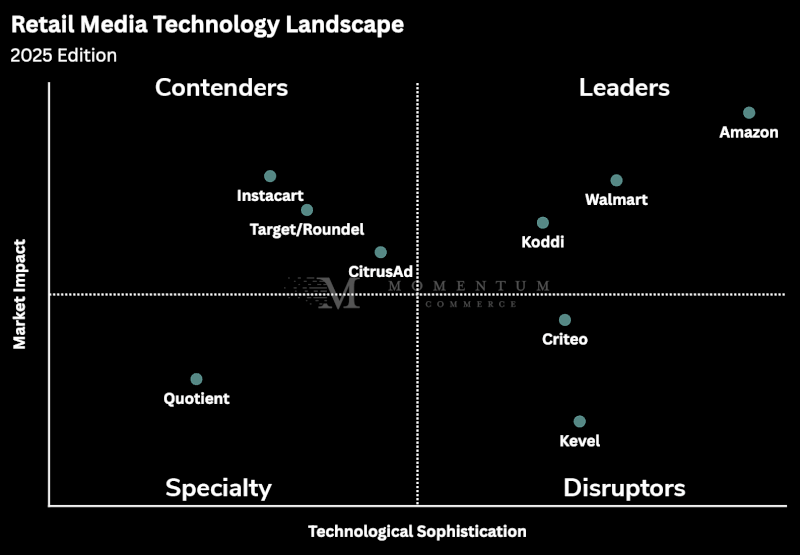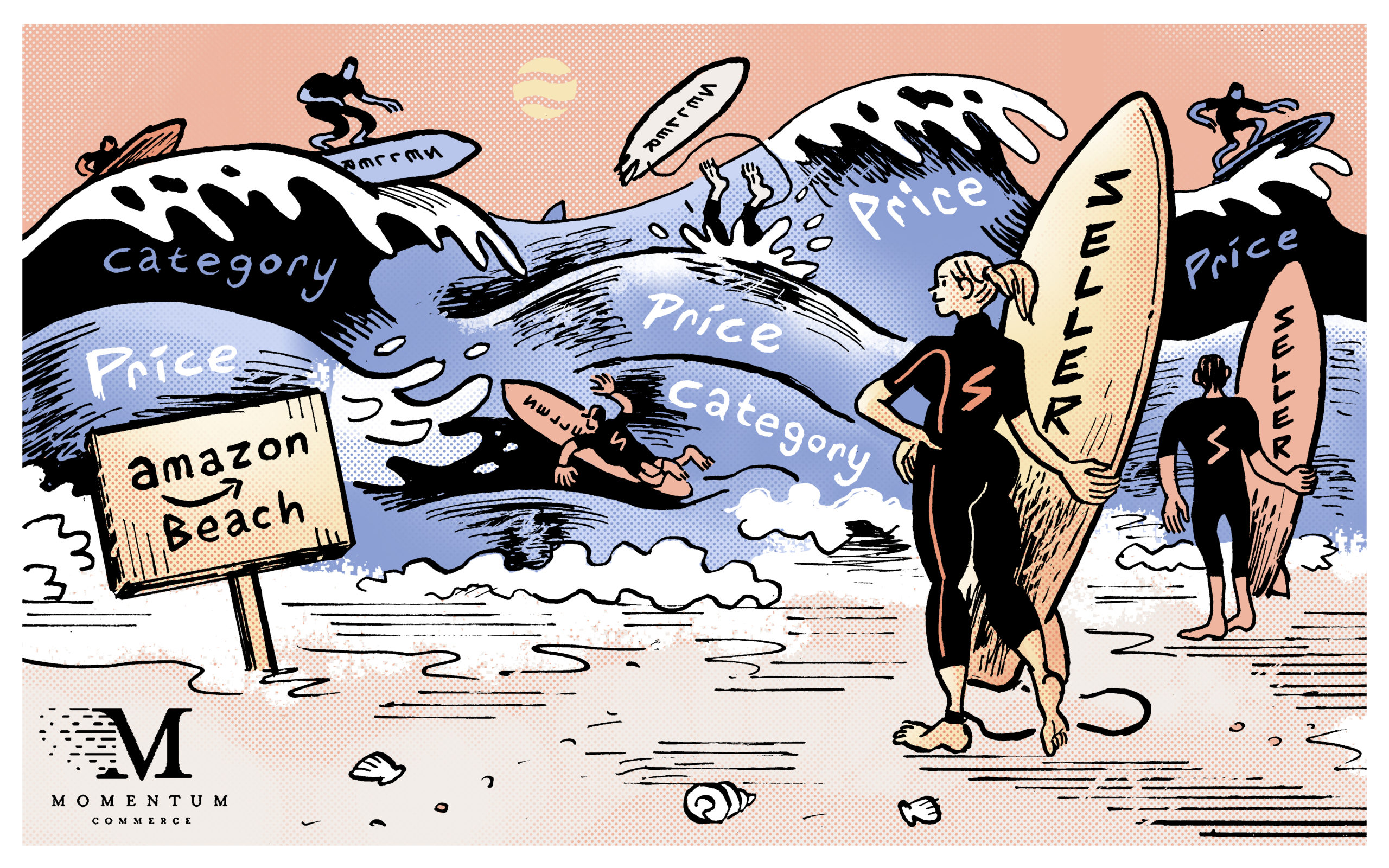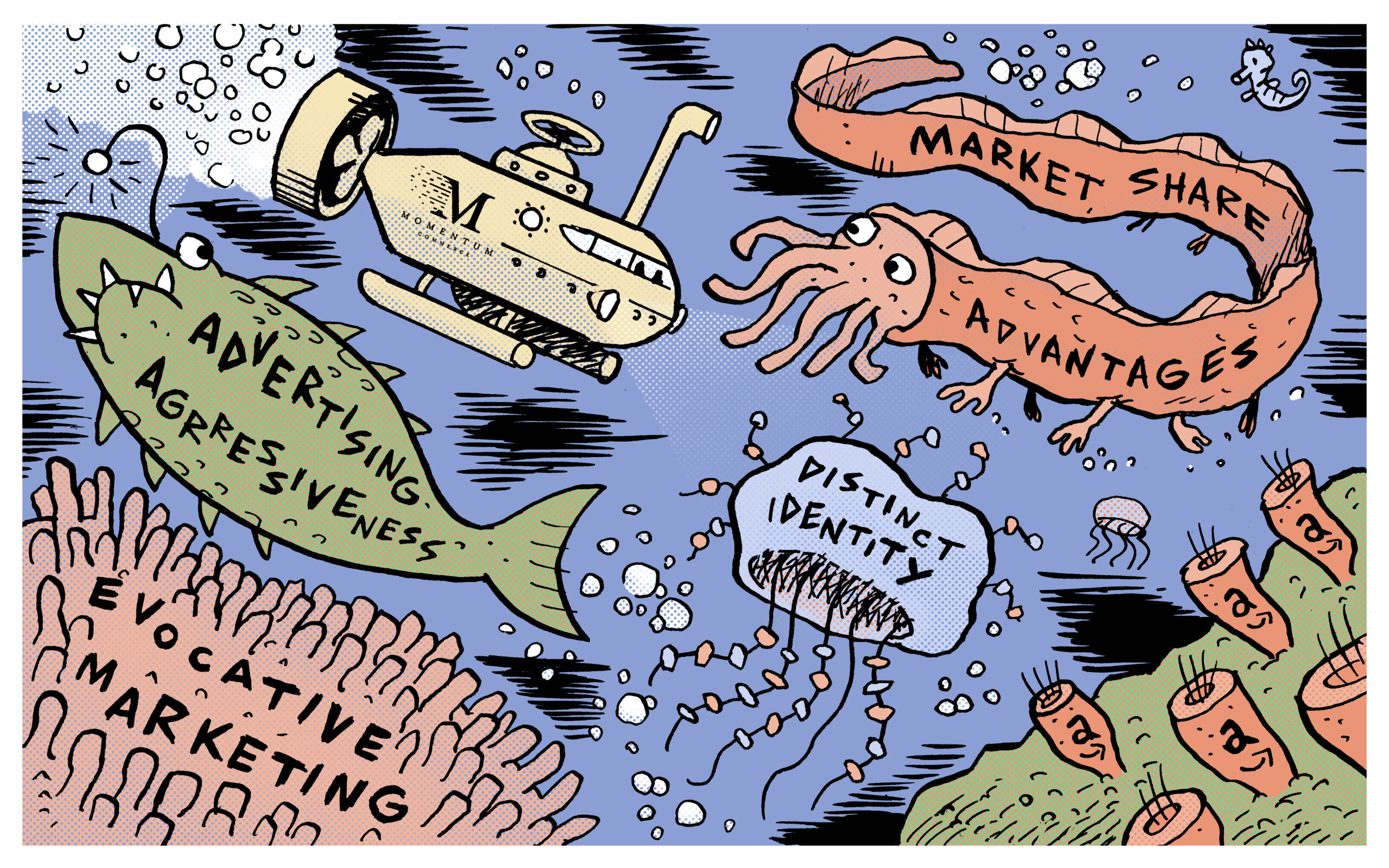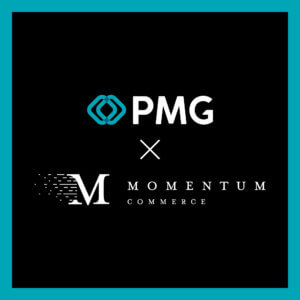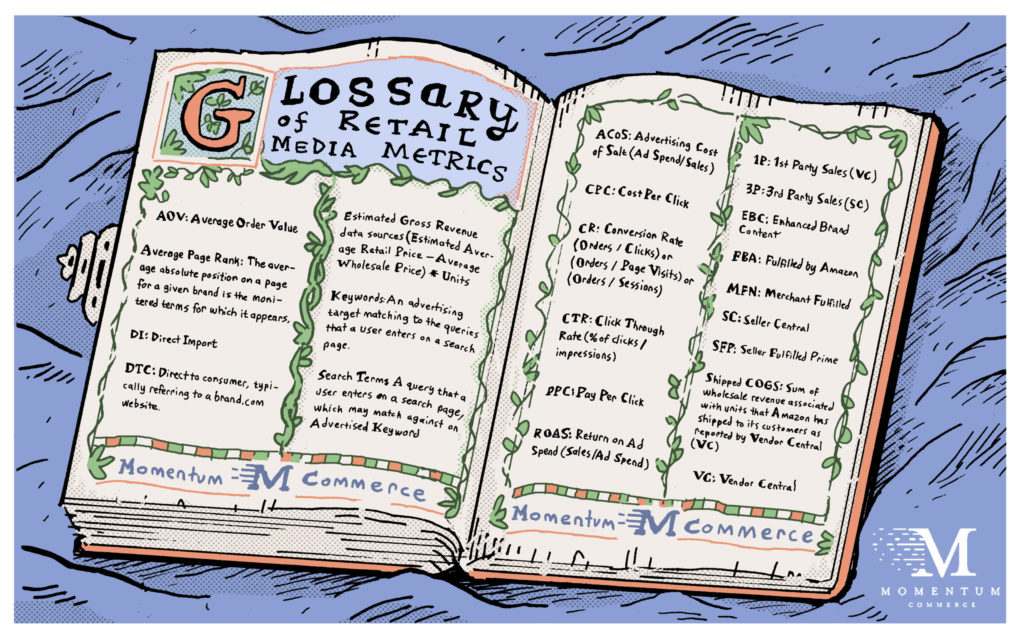
Momentum Commerce & Bayer’s Top Four Retail Media Metrics

Head of Retail Media Activation at Bayer
This is intended to be a reference for Retail Media practitioners at any level. We’ve done our best to put together a comprehensive list of all the metrics, acronyms, and terms that you might encounter on a daily basis. We’ve surely missed some very important concepts. To suggest something we should add please message Ryan.
Rather than a really long list of important things, we also wanted to share a few of the concepts that we believe are critical to success in Retail Media. To ensure some diversity of thought we’ve partnered with our friend Rafa Almeida, Head of Retail Media Activation at Bayer, to discuss the 4 Metrics that Matter Most. Here’s what we came up with:

VP of Strategy at Momentum Commerce
The Most Important Metrics
- TACOS – Total Advertising Cost of Sale. The ultimate measure of success in paid media. Calculated by dividing the sum of a particular product’s total ad spend by the sum of total (ad + organic) sales for that same product.
Rafa feels that ROI/ROAS is equally as important, and we agree direct advertising efficiency is important to measure. Incrementality here is key – efficient ROI or ROAS can be misleading if it’s not generating incremental sales, and the best way to determine if additional ad investment is actually growing product sales is by measuring your TACOS.
The key is figuring out what the right TACOS level is per product and then regularly monitoring performance against this benchmark. I usually recommend a system depending on how competitive your market is, how healthy your margins are, and how new your product is. New products require more investment than well established products. Markets with low competition require less investment to maintain product visibility. And at the end of the day – you should never spend more than your margins after all other costs allow.
- Share – Specifically (SOV) of Non-Brand Search is the frequency that a brand appears in the top 10 positions of a search results page. In this case we are constraining the search terms we are evaluating to strictly Non-Brand terms. These terms are where all of your brand growth is going to come from. Yes, you should defend your brand and measure your Branded SOV. You should also try to capture share from your competitors by targeting and measuring your visibility for their Branded terms. But the most important type of visibility is non-brand search, as it is going to have the most clear relationship to incremental visibility, share, and sales. Shoppers searching for your brand likely already have made the decision to buy from you, but shoppers that are not expressing any brand interest are where you can truly convert new customers and households.
Rafa likes to think about this in terms of incremental revenue share as well. We agree that if you can determine the number of dollars you’re winning out of the addressable market of non-branded search that it’s a useful way to measure your incremental share. Not every brand has access to TAM for categories or sets of searches – so measuring share by visibility can be a more accessible way to understand your share. - Advertising Cost (ACOS / CPC / CPM): Rafa refers to this as simply ‘Scale’. Your total budget determines how much absolute visibility you can acquire for your products on the digital shelf.
The relative cost of how you deploy that scale also matters. As retailers and the networks that they partner with begin to offer more ad formats, buying methods, and media formats the task to evaluate the relative efficiency and effectiveness of paid media is going to become increasingly important. Sometimes the simpler metrics tell the strongest story. If you can buy the same placement several different ways, or have a fixed number of dollars to deploy across the variety of ad formats, always fund the one that is going to give you the biggest return or ‘bang for your buck’ first.
- Market Concentration: We define the market concentration, or the competitiveness of a market, by measuring the share of voice that each brand has in a given category. With this SOV data we compute the Gini coefficient on each category. Gini is most commonly used in economics as a measure of income inequality. A country with all of the wealth held by one person would approach a Gini coefficient of 1, while another country where wealth is completely evenly spread across all of its citizens would have a Gini coefficient of 0. In this case, we simply replace citizens with Brands and wealth with Sponsored Share of Voice, but the concept is the same. The higher the Gini, the more total Share of Voice is held by the top brands. We must consider our absolute SOV in relation to the Gini of the category that we are targeting – we should set goals for more share in less competitive categories, and should not fret if our share is less concentrated in more competitive markets.
With the above in mind, we also wanted to share our expanded glossary of terms, definitions, and metrics for retail media. We’ve started with a focus on Amazon, and will be expanding this article to include additional digital retail platforms each month.
General Retail Media Terms
- Retail Media: Media purchased by a brand on a retailer’s .com website. Examples include Amazon’s Sponsored Products offering, advertising through Walmart Connect or Target’s Roundel, or networks like Criteo, PromoteIQ, and CitrusAd.
- DTC: Direct to Consumer , typically referring to a Brand.com website
- AOV: Average Order Value (Revenue / Orders)
- Average Page Rank: The average absolute position on a page where a brand appears. This is usually measured on search results pages, and can vary depending on the query that a user enters.
- SOV: This can mean a bunch of different things. When we talk about Share of Voice we are referring to the visibility that a product has on a retailer site considering both paid and organic placements. Momentum Commerce currently calculates SOV by measuring the percent of placements where a brand appears in the top 10 positions on a search results page for a given search term. Sometimes SOV can be used to refer to the percentage of a market – whether sales or perhaps even media spend – that a brand controls. A market in this context means either a set of consumers visiting a retailer site or a category or goods.
- Keyword: An advertising target matching to the queries that a user enters on a search page
- Search Term: A query that a user enters on a search page, which may match against an Advertised Keyword
- Estimated Gross Revenue data source: (Estimated Average Retail Price – Average Wholesale Price) * Units
- Digital Shelf: The digital shelf is where shoppers can find a brand’s products, learn about the product, and ultimately choose to purchase the product from a digital retail platform like Amazon, Target.com, Instacart, and others. Similar to how securing shelf placement in physical retail is necessary to drive unit sales, a brand’s products must be visible and differentiated as shoppers search, browse, and buy from their preferred digital store.
- SKU: Stock Keeping Unit. A brand’s unique identifier for a particular product.
- FC: Fulfillment Center. A location where goods are stored and shipped from.
- PDP: Product Detail Page.
- PO: Purchase Order. The document a retailer supplies to a Vendor Brand to purchase goods.
- Vendor Terms: Terms that a vendor agrees to include as part of the commercial arrangement with a retailer. This typically includes a MDF (Market Development Fund), a Returns / Damages allowance, a Freight allowance, and sometimes a pre-negotiated discount or volume incentive. We have also seen negotiated discounts if the retailer pays for the PO early.
General Advertising Terms
- CR: Conversion Rate (Orders / Clicks) or (Orders / Page Visits) or (Orders / Sessions)
- CPC: Cost Per Click
- PPC: Pay Per Click
- CPM: Cost Per Mille. The average cost of 1000 impressions. This form of fee is generally used for Display paid advertising campaigns.
- CTR: Click Through Rate (% of clicks/impressions)
- ACoS: Advertising Cost of Sale (Ad Spend/Sales)
- TACoS: Total Advertising Cost of Sale. (Total Ad Spend / Total Sales). This calculation is useful to do at both the Account and Product level. When calculating at the Product level it’s important to include spend from all ad types where the product may be advertised. This metric helps us understand the total cost of marketing for a Brand or for a product, and can be used to help us monitor profitability. Different brands and product stages call for different investment levels – so there is not an ‘optimal TACOS’ for every situation.
- Attribution: The manner in which sales are associated with paid media. There are several types of interactions that a user may have with an ad and each have their own associated attribution model. The most common attributable interaction types are:
- Click-Through Conversions where a user must click on an ad in order for a conversion to be attributed to media.
- View-Through Conversions where a user must only view an ad in order for a conversion to be attributed to media. Sometimes the model may also require the ad be considered a Viewable Impression.
- Above the Fold: a placement on the page that is within the height of the browser’s window. Basically means a placement, often paid, that a user can view without scrolling.
- Below the Fold: a placement on the page that is below the height of the browser’s window. In other words a placement that a user must scroll down to be able to view. Placements below the fold tend to have less engagement and drive less volume if on a search results page.
- ROAS: Return on Ad Spend (Sales/Ad Spend). This metric is similar and can be used interchangeably with ACOS to measure the efficiency of your advertising investment.
- Display Advertising: A form of paid advertising where the ad unit is a rich media image displayed on a publisher site. Classic examples of publisher sites may be news publications or blogs, but retailers are also beginning to expand the inventory available on their sites to support more Display placements.
- Placements: A location on a website where an advertisement may be placed.
- DSP: Demand Side Platform. An interface with Brands and Agencies can configure and deploy paid media dollars generally for Display advertising formats.
- SSP: Supply Side Platform. An interface where publishers can connect their inventory to be sold to Brands or Advertisers.
- BLS: Brand Lift Study. A measurement tool to help brands understand the effect that media has on business performance. Typically requires an artificial adjustment to the media execution and then measuring the change on a KPI the business cares about. Similar to a scientific experiment, the media execution change would be the independent variable that is adjusted, while the KPI results would be the dependent variable. An example may be increasing media budget and then determining the change in Share of Voice for a particular set of terms.
- DPV: Detail Page View. An interaction consumers can take to engage with retail/e-commerce product listings. Can sometimes be either a click-through DPV or a view-through attributed DPV.
IAS: Integral Ad Science is a 3rd party viewability measurement provider. It is their responsibility to determine whether or not a sponsored impression was in fact viewable by a shopper. - Viewable Impression: A sponsored impression that is visible on a section of a web page that a shopper was viewing. Brands and platforms typically require the impression to be visible for a minimum amount of time in order to be considered viewable.
- KPI: Key Performance Indicator. A metric that a brand determines to be critical to measuring and understanding the performance of their business or their retail media campaigns. In retail media impressions, clicks, and ultimately sales are some of the most common KPIs.
- vCPM: Viewable Cost Per Mille. The media cost for every 1 thousand viewable ad impressions.
- Branded Search: Search queries entered by a shopper that contain a branded term. These could also be terms that are brand owned, but not necessarily a distinct brand manufacturer. An example would be ‘jibbitz’ as a branded term owned by Crocs.
- Non-Branded Search: Search queries entered by a shopper that do not contain any brand terms – ‘blue shoe’ is a good example of a generic search with no specific brand interest.
Amazon-Specific Terms
- VC: Vendor Central – the account management portal for Brands that sell directly to Amazon. These accounts are typically referred to as 1P Vendors.
- SC: Seller Central – the account management portal for Brands that manage their own Seller account and sell goods directly to consumers on the Amazon Marketplace. These accounts are typically referred to as 3P Sellers.
- DI: Direct Import – a Vendor program where amazon takes ownership of goods manufactured internationally at the location of origin. This can change the economics for a vendor.
- Direct Fulfillment: A Vendor program that allows Brands to ship their products directly to consumers without requiring the inventory to be available in an Amazon Fulfillment Center.
- FBA: Fulfilled by Amazon – generally refers to an order where Amazon is responsible for fulfillment and the goods are shipped out of an Amazon FC.
- MFN: Merchant Fulfilled Network – generally refers to a sale where the 3P seller is responsible for fulfillment. The Seller may choose to partner with a 3PL (third party logistics company) like Deliverr.
- SFP: Seller Fulfilled Prime. This is similar to MFN, but it guarantees delivery within the same time frame that FBA Prime shipment would arrive in.
- 1P: 1st Party Sales (VC)
- 3P: 3rd Party Sales (SC)
- Shipped COGS: Sum of wholesale revenue associated with units that Amazon has shipped to its customers as reported by Vendor Central (VC)
- A+ Content: A form of PDP content that allows brands to include more richly designed images, graphics, and text on their PDPs. Including A+ Content is generally associated with improved conversion rates and a better consumer experience. This was formerly referred to as Enhanced Brand Content (EBC).
- EBC: Enhanced Brand Content. Enhanced content that Brands can place on their PDPs. This is currently referred to as A+ Content.
- ASIN: Amazon Standard Identification Number. Amazon’s 10 digit ID to uniquely identify a product on their platform. An ASIN may be related to multiple SKUs if third party sellers are also selling the item. Each SKU would have a corresponding listing on the ASIN’s detail page. There are also both Child and Parent ASINs, where the child might represent different sizes or colors of Parent ASIN products.
- Sponsored Products: The most common type of advertising campaign on Amazon. This ad type most frequently appears in the Search Results Page, but can also appear on Product Detail Pages in the ‘Sponsored Products Related To This Item’ bar.

- Sponsored Brands: An advertising campaign type on Amazon designed to highlight a Brand and a set of its products. This ad type typically appears at the top of a Search Results Page and will contain a link to a Brand Store and usually up to 3 products. This ad type can also appear at the bottom of search results, but will generally be limited to just a link to the Brand’s store page.
- Sponsored Display: An ad type on Amazon that has the broadest set of targeting options and placement possibilities – this ad type is closest to a traditional banner display advertisement. Brands can choose to set targeting expression matching criteria, or select audiences like ‘People Who Recently Visited My Product Detail Page’. This ad format will most frequently appear on Amazon on a PDP, but depending on the targeting type can also appear off of Amazon.com.
- Automatic Campaign: A campaign type where Amazon automatically handles matching without requiring any keywords or targeting expressions to be specified. Amazon will consider the products that are active in the campaign and determine the relevance to shopper search terms automatically. Automatic Campaigns consist of 4 different types of matching where bids can be controlled, including:
- Close match: If the advertised product in the Automatic campaign is “Crocs Classic Clog – Size 7, Blue,” Amazon will show an ad when shoppers use search terms like “clog shoe” and “size 7 shoe”
- Loose match: Amazon will show your ad to shoppers who use search terms loosely related to your products. If the advertised product is Crocs Classic Clog – Size 7, Blue, Amazon will show an ad when shoppers use search terms like “comfortable shoe,” “footwear,” and “blue clothes.”
- Substitutes: Amazon will show your ad to shoppers who view the detail pages of products similar to yours. If the advertised product is Crocs Classic Clog – Size 7, Blue, Amazon will show an ad on product detail pages that include “blue clog” and “size 7 clog”
- Complements: Amazon will show your ad to shoppers who view the detail pages of products that complement your product. If the advertised product is Crocs Classic Clog – Size 7, Blue, Amazon will show an ad on product detail pages that include “socks” and “shoe charms”
- Manual Campaign: A sponsored campaign type where the Brand must supply the keywords or targeting expressions that will be used as the matching criteria for sponsored advertisements to appear.
- Ad Group: An entity type in the hierarchy of a sponsored campaign’s configuration. Ad groups exist as child entities in a parent Campaign. Ad Groups will contain both Ads and Targets. Ads are a form of advertising creative that will appear when the advertisement is placed on Amazon. Amazon generally controls the look and feel of the creative and for a campaign type like Sponsored Products all the brand has to do is specify the ASIN of the product to be advertised. Sponsored Brands and Sponsored Display have some additional creative customization options. Targets are either Keywords or Targeting Expressions, and control when an Ad may be served.
- Broad Match: A keyword type with loose matching criteria. A search query that a user enters may be eligible to match against a Broad Match term if it contains all of the words in the keyword in any order. Amazon also automatically includes pluralization, words it deems related to the keyword, misspellings, and other similar variations of the specified keyword. A keyword can consist of several distinct words. When a search query matches against a specific keyword the keyword is eligible to participate in an ad auction which may ultimately result in an impression. For clarity, here are some examples:
| Keyword | Match Type | Search Term | Match Result |
| Blue shoe | Broad | Blue shoe | True |
| Blue shoe | Broad | Shoe blue | True |
| Blue shoe | Broad | Blue shoe size 5 | True |
| Blue shoe | Broad | Bleu shoe | True |
| Blue shoe | Broad | Blue shoes | True |
| Blue shoe | Broad | Chicken sandwich | False |
- Phrase Match: A keyword with a more narrow matching criteria. All of the words in the keyword must be present in the search term in order for a match to occur, however, with phrase matching the sequence of the words must also match. Phrase Match includes plural forms of the keyword.
| Keyword | Match Type | Search Term | Match Result |
| Blue shoe | Phrase | Blue shoe | True |
| Blue shoe | Phrase | Shoe blue | False |
| Blue shoe | Phrase | Blue shoe size 5 | True |
| Blue shoe | Phrase | Blue shoes | True |
| Blue shoe | Phrase | Chicken sandwich | False |
- Exact Match: The keyword type with the most narrow matching criteria. Only the words expressed in the keyword can be in the search term in order for a match to occur. The sequence must also still match. Exact Match will automatically include close pluralizations of the keyword.
| Keyword | Match Type | Search Term | Match Result |
| Blue shoe | Exact | Blue shoe | True |
| Blue shoe | Exact | Shoe blue | False |
| Blue shoe | Exact | Blue shoe size 5 | False |
| Blue shoe | Exact | Blue shoes | True |
| Blue shoe | Exact | Chicken sandwich | False |
- Targeting Expression: A type of target where a product, category, or set of product attributes like price, rating, or Brand is specified.
- Negative Keyword: A type of keyword that can be used to prevent sponsored advertisements from appearing for specific queries. Frequently used to prevent non-branded keywords from serving advertisements against Branded search queries.


